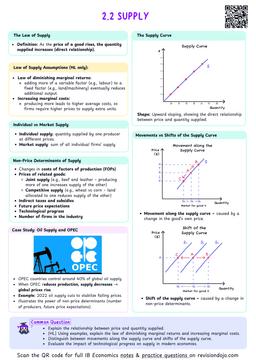Macroeconomic equilibrium
The point where aggregate demand intersects aggregate supply, establishing the price level and the real output (real GDP) of an economy.
Short-run Equilibrium
In the short run, the economy is in equilibrium when the aggregate demand (AD) curve intersects the short-run aggregate supply curve (SRAS).

As can be seen in Figure 1 above, the AD and SRAS curves intersect at:
- Equilibrium price level ($Pl_e$)
- Equilibrium real output ($Y_e$)
The economy is at equilibrium when the AD and SRAS curves intersect because:
- If the economy's price level was higher than $Pl_e$, such as $Pl_1$:
- There would be an excess of real output produced and not demanded.
- This would encourage producers across the economy to reduce the final price of goods and services, decreasing the price level.
- With fixed costs of production and lower profit margins, producers reduce their output.
- This downward pressure on the price level persists until AS meets AD at $Pl_e$, $Y_e$.
- If the economy's price level was lower than $Pl_e$, such as $Pl_2$:
- There would be an excess amount of real output demanded and not produced.
- This would encourage producers across the economy to increase the final price of goods and services This would increase the price level.
- As the price level rises, the quantity demanded gradually decreases, and the quantity supplied increases, moving the economy toward equilibrium.
- This upward pressure on the price level persists until AS meets AD at $PL_e$, $Y_e$.
Shifts in AD / SRAS: a new equilibrium
If there is a shift in AD / SRAS due to a change in one of their determinants, a new equilibrium price level and real output is set.

Figure 2 above shows two possible hypothetical shifts of an initial AD curve (AD1).
- Originally:
- Equilibrium occurs when AD1 meets SRAS.
- Equilibrium price level = PL1
- Equilibrium real output = Y1
- Rightward shift of AD (AD1→AD2):
- Now, SRAS meets AD2 at a new equilibrium.
- Equilibrium price level = PL2 (increase from PL1→PL2)
- Equilibrium real output = Y2 (increase from Y1→Y2)
- Leftward shift of AD (AD1→AD3):
- Now, SRAS meets AD3 at a new equilibrium.
- Equilibrium price level = PL3 (decrease from PL1→PL3)
- Equilibrium real output = Y3 (decrease from Y1→Y3)

Figure 3 above shows two possible hypothetical shifts of an initial SRAS curve (SRAS1).
- Originally:
- Equilibrium occurs when AD meets SRAS1.
- Equilibrium price level = PL1
- Equilibrium real output = Y1
- Rightward shift of SRAS (SRAS1→SRAS2):
- Now, AD meets SRAS2 at a new equilibrium.
- Equilibrium price level = PL2 (decrease from PL1→PL2)
- Equilibrium real output = Y2 (increase from Y1→Y2)
- Leftward shift of SRAS (SRAS1→SRAS3):
- Now, AD meets SRAS3 at a new equilibrium.
- Equilibrium price level = PL3 (increase from PL1→PL3)


